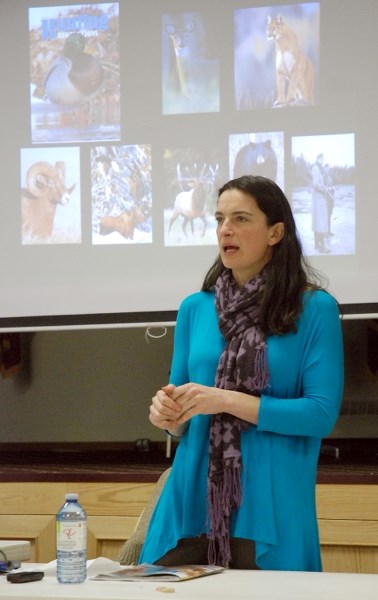An annual wildlife management meeting provides a chance for residents to not only learn about regulatory changes but also to share concerns or offer input.
"I really think that it's a good opportunity for people who are interested in wildlife management to sit down with the biologist and managers of these areas," said Larry Nielsen, president of the Sundre Trappers' Association and member of the Sundre Fish and Game Association.
This year's meeting was held on Wednesday, Feb. 17 at the Sundre Legion. About two-dozen people attended.
The turnout was down a bit from past meetings, but it's all relative because every year there are different issues or problems, some of which tend to draw out a larger crowd, said Chiara Fedes, a Fish and Wildlife biologist who's based in Rocky Mountain House.
For instance, last year's meeting saw a higher attendance over a pending decision to change the legal definition of bighorn sheep, she said.
"We need to limit the number of animals that get killed every year."
That means redefining what qualifies as a legal ram. A younger sheep that is harvested between the ages of four and six years old did not reach its full reproduction potential, she said.
"It's important for them to have big horns and heavy mass ó that happens after seven years."
A ram becomes dominant, depending on competition from its herd, by the age of seven. If it is shot before then, chances are the animal did not get an opportunity to reproduce, she said.
"They are growing at a slower rate than what they were before."
This led to the proposal to change the legal definition of rams by increasing the minimum age at which the animals can be harvested, she said.
Another issue from past years that brought out more people to the meetings was elk in the Bergen area. However, due to either changes in regulations or a mild winter ó or a combination of both ó there haven't been as many issues with elk recently, she said.
Considering there weren't such big issues this year, the meeting's attendance of about two dozen was fairly good, she said.
"It's about that every year when there is no major problem."
One of the main topics for discussion this year was regulatory changes for cougar management, she said, adding two proposals are being moved forward to allow additional opportunities for hunters to harvest cougars.
The main goal of the meetings is to keep a channel open for discussion on wildlife management issues and also to consult with stakeholders and community members, she said.
"The stakeholder input is fundamental to us," she said.
"If we think that what they're proposing has value, we bring it down the line."
From there, officials determine if it's possible to change regulations, or whether they want to make any changes, she added.
Nielsen said he was pleased to see the progress made on cougar management and that there has been good communication with Fedes and the Fish and Wildlife office in Rocky Mountain House.
"It speaks well that we work together in that way. That, to me, is something that's really important, that they're willing to sit down and hear concerns. Certainly they'll filter some of those out, but they give people a chance to raise questions," he said.
One issue on which Nielsen has a difference of opinion is the proposal to change the legal definition of a bighorn ram. Aside from increasing the age and therefore size of a legal animal, there has also been talk of putting bighorn sheep on a draw, which would limit how many hunters can harvest the animals. Although he doesn't feel that any changes are warranted to begin with, he would prefer to see the size restrictions altered than a limited draw imposed.
While the overall bighorn sheep population has not dropped, the number of available rams to harvest has. Officials attribute that decrease to hunters, but Nielsen says it's due to predation.
As for cougars, he was glad to hear about the increased quota in certain cougar management areas, which includes parts of the Sundre region.
"I really believe that predator management is an integral part of the process."
Members of groups like the Sundre Trappers' Association and the Sundre Fish and Game Association are the last people who want predators like bears, cougars and wolves to disappear, he said.
"They're part of the balance."
However, there should be tighter management, he said.
Anyone who wants to know more about regulatory changes and proposals that are underway can either reach Fedes at her office by calling 403-845-8250 or by contacting the district Fish and Wildlife office in Sundre at 403-638-3805.




